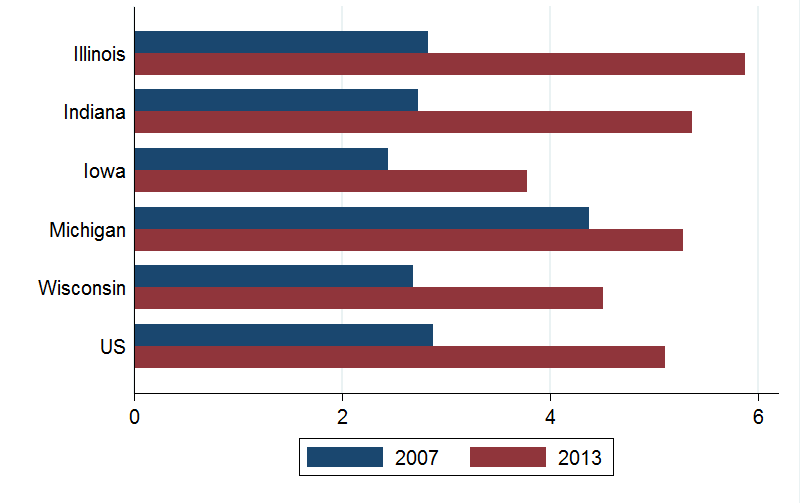Are Seventh District Labor Markets Still Slack?
There is no question that the U.S. labor market has been gradually but steadily healing after the Great Recession. The national unemployment rate peaked at 10% in October 2009, but it has since fallen to 6.2% (as of July 2014). The nation experienced a net loss of 8.7 million jobs during the downturn, and finally finished making up for those job losses just this past May. So, undeniably, progress has been made in the labor market, but now the questions facing policymakers and other government officials are how much slack capacity in the employable population remains and whether further tightening of labor market conditions will push up wages and prices.
Recently, short-term unemployment—defined as the share of the labor force that has been unemployed for 26 weeks or less (see below)—has fallen to levels that have been historically associated with robust economic conditions. In contrast, despite post-recessionary declines in long-term unemployment (i.e., the share of the labor force that has been unemployed for greater than 26 weeks), its recent levels remain well above the historical norm. Though high long-term unemployment may be a sign of considerable labor market slack, some argue that the vast majority of the long-term unemployed lack the specific skills and other characteristics to be hired or trained. If this proves to be correct, it would imply that the U.S. labor market is nearing its full capacity.
1. Unemployment duration and part-time work

In order to provide more useful guideposts for macroeconomic policymaking, economists Dan Aaronson and Andrew Jordan recently investigated the relationships between rising wages and indicators of labor market tightness. In their recent Chicago Fed Letter, the authors find a strong correlation between real wage growth and two prominent measures of labor market slack—medium-term unemployment (i.e., the share of labor force unemployed for five to 26 weeks) and the percentage of the labor force reporting they are working part-time involuntarily for economic reasons (such as unfavorable business conditions or seasonal decreases in demand). Partly because both of these measures of labor slack remain elevated today, the authors conclude that real wage growth in June 2014 would have been one-half of a percentage point to one full percentage point higher under the labor market conditions of the 2005-07 U.S. economy.
While we often speak of the labor market as one monolithic term, labor market conditions vary widely by occupation, industry, and location. In their analyses, Aaronson and Jordan identify statistical relationships between real wage growth and labor market conditions by observing individual states. In the chart below, we see the general pace of employee compensation for both the United States and for the East North Central Region, which includes four of the five states of the Seventh Federal Reserve District.1 In both the nation and the region, recent growth in labor compensation continues to fall short of that in the pre-recessionary period.2
2. Employment cost index: Private industry workers

Also, as seen in the next three charts, Seventh District states generally exhibited signs of greater labor market slack in 2013 relative to the pre-recession year of 2007.3 Long-term unemployment—both in the Seventh District states and in the nation—has stayed high during the economic recovery. In 2013, the long-term unemployment rate in Illinois was the highest among the District states (followed by Michigan). Notably, Michigan’s long-term unemployment rate had been at a high rate already in 2007 as a result of the severe restructuring of the automotive industry in the past decade.
3. Long-term unemployment rate (27+ weeks)

Medium-term measures also remained elevated among Seventh District states in 2013. However, they suggested that the District’s state labor markets may be less slack than the national one; in particular, Iowa and Wisconsin, where 2013 medium-term unemployment rates had almost returned to their 2007 levels, showed their labor markets may be improving faster than the nation’s.
4. Medium-term unemployment rate (5-26 weeks)

According to the measures of the percentage of the labor force who are involuntary part-time workers, there also appeared to be additional work force supply available in both the Seventh District states and the nation in 2013 as compared with 2007. This was the case for all five District states. Moreover, it should be noted that Michigan, Indiana, and Illinois displayed a higher percentage of involuntary part-timers than the nation did in 2013. Involuntary part-time workers are those who would choose to work more hours if it were possible. Typically, such workers have had their hours cut back in their current job, or they are part-time workers who cannot find a full-time job due to poor economic conditions in their occupation.4
5. Percent of labor force working part-time for economic reasons

As these measures indicate, even while labor markets continue to tighten in the economic recovery, there is significant variation across states. According to the charts above, state labor markets in the Seventh District continue to be somewhat slack. Further, the observed pace of wage and employee compensation increases are still below those of the pre-recessionary period.
Footnotes
1 The Federal Reserve’s Seventh District comprises major parts of Indiana, Illinois, Michigan, and Wisconsin, as well as the entirety of Iowa. The U.S. Census Bureau’s East North Central Region comprises Ohio and the entirety of the Seventh District states excepting any part of Iowa.
2 Labor compensation includes both employee wages and benefits.
3 State averages are reported here, though we acknowledge that local conditions and markets for specific skills and occupations differ. The Chicago Fed’s regional research staff keeps abreast of such conditions and markets through local meetings with labor market participants and businesses, as well as through formal surveys.
4 For a full discussion see Rob Valletta and Leila Bengalli, “What’s Behind the Increase in Part-time Work?“








